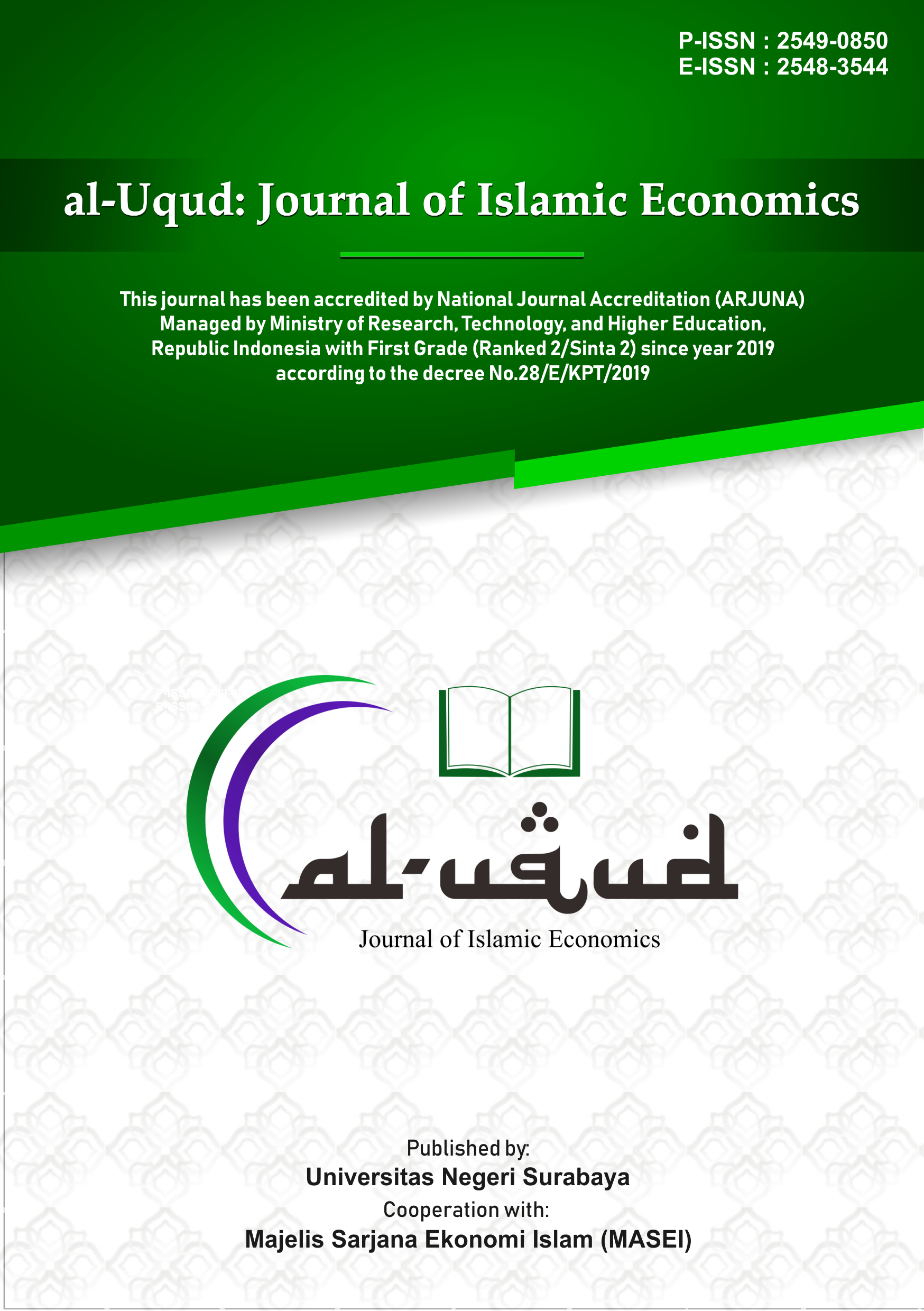Improving digital payment system services: The impact of e-service quality and e-Loyalty on user preferences
DOI:
https://doi.org/10.26740/al-uqud.v8n2.p302-313Keywords:
E-service Quality, E-loyalty, E-walletAbstract
This research aims to provide deeper insights into user preferences and the factors influencing their choices in using Digital Payment Systems, particularly in the context of the DANA e-wallet as an alternative to BI-Fast during service improvement periods. The study focuses on key variables such as E-System Quality and E-Loyalty. The findings indicate that the constructs of E-Loyalty and E-Service Quality demonstrate high levels of validity and reliability, and there exists a significant relationship between electronic service quality and electronic loyalty. Data analysis also identifies specific dimensions of DANA e-wallet service quality that have a significant impact on user preferences and loyalty levels. Factors such as compensation, ease of link access, and ease of contacting customer service are aspects that need attention to enhance service quality. Thus, the research conclusion provides valuable guidance for other Digital Payment Systems owners or managers to improve their service quality and strengthen customer relationships, akin to what is done by DANA e-wallet. These findings offer valuable guidance for other e-wallet owners or managers to enhance their service quality, focusing on aspects such as compensation, link access convenience, and ease of contacting customer service. The importance of improving electronic service quality to achieve higher customer loyalty should be emphasized by stakeholders in the digital payment industry, with specific steps that can be taken based on these findings to strengthen customer relationships and maintain competitive advantages.
References
Ahmad, A., Rahman, O., & Khan, M. . (2017). Exploring the role of website quality and hedonism in the formation of e-satisfaction and e-loyalty: Evidence from Internet users in India. Journal of Research in Interactive Marketing, 11(3), 246–267. https://doi.org/https://doi.org/10.1108/JRIM-04-2017-0022
Al-Dweeri, R. M. (2019). The effect of e-service quality on Jordanian student’s e-loyalty: an empirical study in online retailing. Industrial Management & Data Systems, 119(4), 902–923. https://doi.org/https://doi.org/10.1108/IMDS-12-2017-0598
Balakrishnan, B. K. P. D., Dahnil, M. I., & Yi, W. J. (2014). The Impact of Social Media Marketing Medium toward Purchase Intention and Brand Loyalty among Generation Y. Procedia - Social and Behavioral Sciences, 148, 177–185. https://doi.org/10.1016/j.sbspro.2014.07.032
Borishade, T. T., Ogunnaike, O. O., Salau, O., Motilewa, B. D., & Dirisu, J. I. (2021). Assessing the relationship among service quality, student satisfaction and loyalty: the NIGERIAN higher education experience. Heliyon, 7(7), e07590. https://doi.org/10.1016/j.heliyon.2021.e07590
Çelik, K. (2021). The Effect Of E-Service Quality And After-Sales E-Service Quality On E-Satisfaction. Business & Management Studies: An International Journal, 9(3), 1137–1155. https://doi.org/Https://Doi.Org/10.15295/Bmij.V9i3.1898
Chan-Olmsted, S., Wang, R., & Hwang, K. H. (2022). Millennials’ Adoption of Radio Station Apps: The Roles of Functionality, Technology, Media, and Brand Factors. Journalism and Mass Communication Quarterly, 99(1), 262–288. https://doi.org/10.1177/1077699020952111
Chao, S.-L., Yu, M.-M., & Wei, S.-Y. (2024). Ascertaining the impact of e-service quality on e-loyalty for the e-commerce platform of liner shipping companies. Transportation Research Part E: Logistics and Transportation Review, 184(2). https://doi.org/https://doi.org/10.1016/j.tre.2024.103491
Haza Fatikah, B., & Albanna, H. (2022). The Influence of E-Servqual and E-Trust on E-Loyalty : The Role of E-Satisfaction as an Intervening on Islamic Mobile Banking Customer. Journal of Business Management and Islamic Banking, 1(1), 119–130. https://doi.org/10.14421/jbmib.2022.011-08
Hendartyo, M. (2023). Bank Indonesia: e-Money Transaction Value Grows 66.65% in January. Tempo.Co. https://en.tempo.co/read/1559724/bank-indonesia-e-money-transaction-value-grows-66-65-in-january
Ighomereho, S. O., Ojo, A. A., Omoyele, S. O., & Olabode, S. O. (2022). From Service Quality to E-Service Quality: Measurement, Dimensions and Model. Journal of Management Information and Decision Sciences, 25(1), 1–15. https://doi.org/10.48550/arXiv.2205.00055
Ilyas, Azmi, U., & Safrijal, S. (2023). The Effect of Applying the Project Based Learning Model Against Student Learning Outcomes. International Journal of Social Science, 3, 215–222. https://doi.org/10.53625/ijss.v3i2.6304
Irwan, & Adam, K. (2020). Metode Partial Least Square (Pls) Dan Terapannya. Teknosains, 9(1), 53–68.
Juwaini, A., Chidir, G., Novitasari, D., Iskandar, J., Hutagalung, D., Pramono, T., Maulana, A., Safitri, K., Fahlevi, M., Sulistyo, A. B., & Purwanto, A. (2022). The Role of Customer E-Trust, Customer E-Service Quality and Customer E-Satisfaction on Customer E-Loyalty. International Journal of Data and Network Science, 6(2), 477–486. https://doi.org/10.5267/j.ijdns.2021.12.006
Lionello, R. L., Slongo, L. A., & Matos, C. A. de. (2020). Electronic Service Quality: a Meta-Enalysis. Marketing Intelligence & Planning, 38(5), 619–635.
Liu, F., Lim, E. T. K., Li, H., Tan, C. W., & Cyr, D. (2020). Disentangling utilitarian and hedonic consumption behavior in online shopping: An expectation disconfirmation perspective. Information and Management, 57(3). https://doi.org/10.1016/j.im.2019.103199
Maleong, L. (2019). Metodologi Penelitian Kualitatif. PT. Remaj Rosda Karya.
Mufidah, E. N. (2021). Pengaruh Kualitas Layanan Dan Kualitas Produk Terhadap E-satisfaction Pelanggan Muslim Yang Berbelanja Di Tokopedia. IAIN Kudus.
Nguyen, T. D., Banh, U. U. T., Nguyen, T. M., & Nguyen, T. T. (2023). E-Service Quality: A Literature Review and Research Trends. Lecture Notes in Networks and Systems, 578(January), 47–62. https://doi.org/10.1007/978-981-19-7660-5_5
Oliver, R. L., & Bearden, W. O. (1985). Disconfirmation processes and consumer evaluations in product usage. Journal of Business Research, 13(3), 235–246. https://doi.org/https://doi.org/10.1016/0148-2963(85)90029-3
Pilishvili, A. S. (2020). The Impact of Digital Technology on the Development Strategy of a Financial Corporation. 1st International Conference on Emerging Trends and Challenges in the Management Theory and Practice (ETCMTP 2019), 119(Etcmtp 2019), 71–74. https://doi.org/10.2991/aebmr.k.200201.015
Qazi, A., Tamjidyamcholo, A., Raj, R. G., Glenn, H., & Craig, S. (2017). Assessing consumers’ satisfaction and expectations through online opinions: Expectation and disconfirmation approach. Computers in Human Behavior, 75, 450–460. https://doi.org/https://doi.org/10.1016/j.chb.2017.05.025
Rahahleh, A., Al-Nsour, S., Moflih, M., Alabaddi, Z., Al-Nassar, B., & Al-Nsour, N. (2020). The Influence of Electronic Service Quality on Relationship Quality: Evidence From Tourism Industry. Management Science Letters, 10(12), 2759–2768. https://doi.org/10.5267/j.msl.2020.4.034
Subagiyo, R., Mutafarida, B., Nur Asiyah, B., Bachtiar, J., & Fauzan, F. (2022). Islamic Bank Customer Loyality: An Analysis of Griffin’s Theory and Relevant Research. ULUL ALBAB Jurnal Studi Islam, 23(1), 42–69. https://doi.org/10.18860/ua.v23i1.15892
Sweeny, K. (2018). On the Experience of Awaiting Uncertain News. Current Directions in Psychological Science. Current Directions in Psychological Science, 27(4), 281–285.
Taherdoost, H. (2019). Electronic service quality measurement: development of a survey instrument to measure the quality of e-service. International Journal of Intelligent Engineering Informatics, 7(6), 491. https://doi.org/doi:10.1504/ijiei.2019.104559
Tarka, P. (2017). The comparison of estimation methods on the parameter estimates and fit indices in SEM model under 7-point Likert scale. Archives of Data Science, 2(1), 1–16. https://doi.org/10.5445/KSP/1000058749/10
Yang, Z., Peterson, R. T., & Cai, S. (2003). Services quality dimensions of Internet retailing: An exploratory analysis. Journal of Services Marketing, 17(7), 685–700. https://doi.org/10.1108/08876040310501241
Zehir, C., & Narcıkara, E. (2016). E-Service Quality and E-Recovery Service Quality: Effects on Value Perceptions and Loyalty Intentions. Procedia - Social and Behavioral Sciences, 229, 427–443. https://doi.org/10.1016/j.sbspro.2016.07.153
Downloads
Published
How to Cite
Issue
Section
License

This work is licensed under a Creative Commons Attribution 4.0 International License.
CC BY 4.0 Abstract views: 573
,
Abstract views: 573
, PDF Downloads: 308
PDF Downloads: 308








